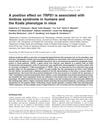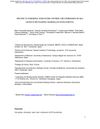TLDR The mouse hairy ears mutation causes longer ear hair due to changes in gene expression.
The study on the mouse hairy ears (Eh) mutation found that this mutation led to an extended anagen phase in hair follicles, resulting in longer hair on the ears. This was linked to an inversion on chromosome 15, which altered the expression of Hoxc genes, particularly Hoxc8 and Hoxc9, without disrupting any protein-coding genes. The findings suggested that the hair phenotype was due to position effects on gene expression near the inversion breakpoints, providing insights into the genetic mechanisms underlying hair growth and development.
 60 citations
,
August 2008 in “Human molecular genetics online/Human molecular genetics”
60 citations
,
August 2008 in “Human molecular genetics online/Human molecular genetics” A position effect on the TRPS1 gene causes excessive hair growth in humans and mice.
58 citations
,
November 2004 in “The journal of investigative dermatology/Journal of investigative dermatology” The Foxn1 gene is essential for normal nail and hair development.
98 citations
,
April 2003 in “Die Naturwissenschaften” 114 citations
,
May 2001 in “Development” Overexpression of Hoxc13 in hair cells causes hair loss and skin issues.
69 citations
,
May 1997 in “Veterinary Pathology” The angora mouse mutation causes long hair and hair defects due to a gene deletion.
135 citations
,
May 1994 in “Medical Entomology and Zoology” Mouse models help study genetic skin diseases.
 43 citations
,
August 2018 in “Cell Stem Cell”
43 citations
,
August 2018 in “Cell Stem Cell” Hoxc genes control hair growth through Wnt signaling.
25 citations
,
November 2020 in “Proceedings of the National Academy of Sciences” HoxC genes are crucial for normal hair and nail development.
 June 2020 in “bioRxiv (Cold Spring Harbor Laboratory)”
June 2020 in “bioRxiv (Cold Spring Harbor Laboratory)” The HoxC gene cluster and its enhancers are essential for developing hair and nails in mammals.
 17 citations
,
June 2019 in “BMC genomics”
17 citations
,
June 2019 in “BMC genomics” Non-coding RNAs help control hair growth in cashmere goats.
35 citations
,
April 2008 in “Journal of Biological Chemistry” Hirosaki hairless rats lack hair due to missing DNA with key keratin genes.



